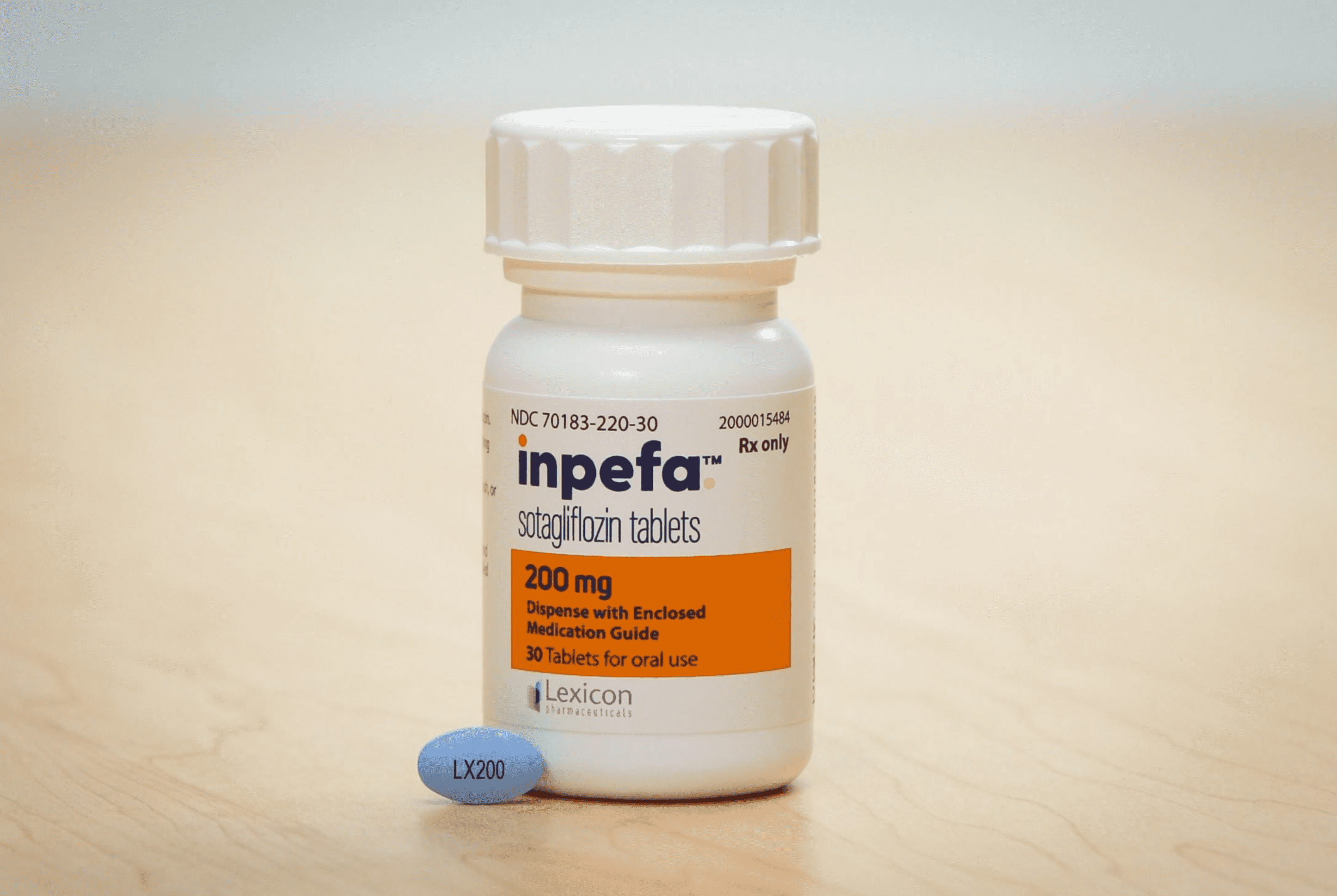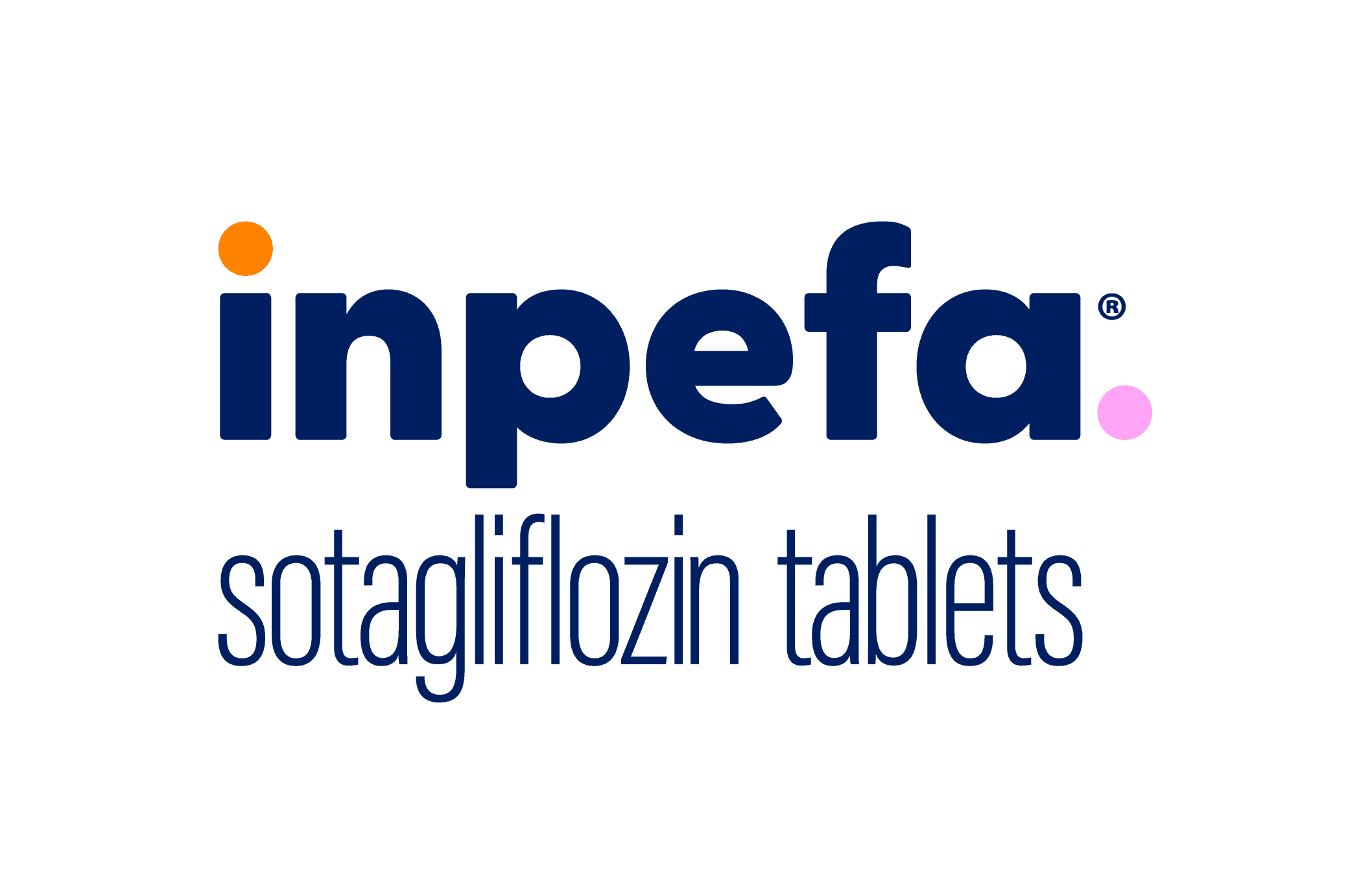Products
INPEFA® (sotagliflozin)
An option for the treatment of Heart Failure (HF)
INPEFA is a once-daily oral tablet to reduce the risk of cardiovascular death, hospitalization for heart failure, and urgent heart failure visit in adults with:
- heart failure or
- type 2 diabetes mellitus, chronic kidney disease, and other cardiovascular risk factors.1
SOLOIST-WHF included 1,222 patients recently hospitalized for worsening HF.2 Results showed:
HR=0.67 (95% CI 0.53-0.85, p=0.001)
HR=0.49 (95% CI 0.27-0.91)
HR=0.62 (95% CI 0.39-0.99)
Most common adverse reactions (incidence ≥ 5%) of INPEFA include urinary tract infection, volume depletion, diarrhea, and hypoglycemia. Before initiating INPEFA, assess risk factors for ketoacidosis. If ketoacidosis is suspected, discontinue and treat promptly.
For more information see our INPEFA fact sheet
References
- U.S. Food and Drug Administration. Novel Drug Approvals for 2023 [Internet] 2023 [cited May 2023]: https://www.fda.gov/drugs/new-drugs-fda-cders-new-molecular-entities-and-new-therapeutic-biological-products/novel-drug-approvals-2023
- Bhatt DL, Szarek M, Steg PG, et al. Sotagliflozin in patients with diabetes and recent worsening heart failure. N Engl J Med. 2021;384(2):117-128. https://www.nejm.org/doi/full/10.1056/NEJMoa2030183
Important Safety Information (ISI) for INPEFA
Indication
INPEFA® is indicated to reduce the risk of cardiovascular death, hospitalization for heart failure, and urgent heart failure visit in adults with:
- heart failure or
- type 2 diabetes mellitus, chronic kidney disease, and other cardiovascular risk factors
Important Safety Information
Dosing: Assess renal function and volume status and, if necessary, correct volume depletion prior to initiation of INPEFA. INPEFA dosing for patients with decompensated heart failure may begin when patients are hemodynamically stable, including when hospitalized or immediately upon discharge.
Contraindications: INPEFA is contraindicated in patients with hypersensitivity to any component.
Read MoreWarnings and Precautions:
Ketoacidosis: INPEFA increases the risk of ketoacidosis in patients with type 1 diabetes mellitus (T1DM). Type 2 diabetes mellitus (T2DM) and pancreatic disorders are also risk factors. The risk of ketoacidosis may be greater with higher doses. There have been postmarketing reports of fatal events of ketoacidosis in patients with type 2 diabetes using sodium glucose transporter 2 (SGLT2) inhibitors. Before initiating INPEFA, assess risk factors for ketoacidosis. Consider ketone monitoring in patients with T1DM and consider ketone monitoring in others at risk for ketoacidosis, and educate patients on the signs/symptoms of ketoacidosis. Patients receiving INPEFA may require monitoring and temporary discontinuation of therapy in clinical situations known to predispose to ketoacidosis.
Assess patients who present with signs and symptoms of metabolic acidosis or ketoacidosis, regardless of blood glucose level. If suspected, discontinue INPEFA, evaluate, and treat promptly. Monitor patients for resolution of ketoacidosis before restarting INPEFA.
Volume Depletion: INPEFA can cause intravascular volume depletion which may sometimes manifest as symptomatic hypotension or acute transient changes in creatinine. There have been post-marketing reports of acute kidney injury, some requiring hospitalization and dialysis, in patients with type 2 diabetes mellitus receiving SGLT2 inhibitors. Patients with impaired renal function (eGFR < 60 mL/min/1.73 m2), elderly patients, or patients on loop diuretics may be at increased risk for volume depletion or hypotension. Before initiating INPEFA in patients with one or more of these characteristics, assess volume status and renal function, and monitor for signs and symptoms of hypotension during therapy.
Urosepsis and Pyelonephritis: Treatment with SGLT2 inhibitors, including INPEFA, increases the risk for urinary tract infections. Serious urinary tract infections including urosepsis and pyelonephritis requiring hospitalization have been reported. Evaluate patients for signs and symptoms of urinary tract infections and treat promptly.
Hypoglycemia with Concomitant Use with Insulin and Insulin Secretagogues: Insulin and insulin secretagogues are known to cause hypoglycemia. INPEFA may increase the risk of hypoglycemia when combined with insulin or an insulin secretagogue. Therefore, a lower dose of insulin or insulin secretagogue may be required to minimize the risk of hypoglycemia when used with INPEFA.
Necrotizing Fasciitis of the Perineum (Fournier's Gangrene): Reports of Fournier's Gangrene, a rare but serious and life-threatening necrotizing infection requiring urgent surgical intervention, have been identified in post-marketing surveillance in patients with diabetes mellitus receiving SGLT2 inhibitors. Assess patients who present with pain, tenderness, erythema, or swelling in the genital or perineal area, along with fever or malaise. If suspected, start treatment immediately with broad-spectrum antibiotics and, if necessary, surgical debridement. Discontinue INPEFA, closely monitor patient signs and symptoms, and provide appropriate alternative therapy for heart failure.
Genital Mycotic Infections: INPEFA increases the risk of genital mycotic infections. Monitor and treat as appropriate.
Urinary Glucose Test and 1,5-anhydroglucitol (1,5-AG) Assay: these are not reliable for patients taking SGLT2 inhibitors. Use alternative testing methods to monitor glucose levels.
Common Adverse Reactions: the most commonly reported adverse reactions (incidence ≥ 5%) were urinary tract infection, volume depletion, diarrhea, and hypoglycemia.
Drug Interactions:
- Digoxin: Monitor patients appropriately as there is an increase in the exposure of digoxin when coadministered with INPEFA 400 mg.
- Uridine 5'-diphospho-glucuronosyltransferase (UGT) Inducer: The coadministration of rifampicin, an inducer of UGTs, with sotagliflozin resulted in a decrease in the exposure of sotagliflozin.
- Lithium: Concomitant use of an SGLT2 inhibitor with lithium may decrease serum lithium concentrations. Monitor serum lithium concentration more frequently during INPEFA initiation and with dosage changes.
Use in Specific Populations:
- Pregnancy and Lactation: INPEFA is not recommended during the second and third trimesters of pregnancy, nor while breastfeeding.
- Geriatric Use: No INPEFA dosage change is recommended based on age. No overall differences in efficacy were detected between these patients and younger patients, and other reported clinical experience has not identified differences in responses between the elderly and younger patients, but greater sensitivity of some older individuals cannot be ruled out. Elderly patients may be at increased risk for volume depletion adverse reactions, including hypotension.
- Renal Impairment: INPEFA was evaluated in patients with chronic kidney disease (eGFR 25 to 60 mL/min/1.73 m2) and in patients with heart failure with eGFR <60 mL/min/1.73 m2. The safety profile of INPEFA across eGFR subgroups in these studies was consistent with the known safety profile. There was an increase in volume-related adverse events (e.g., hypotension, dizziness) in patients with eGFR <30 mL/min/1.73m2 relative to the overall safety population. Efficacy and safety studies with INPEFA did not enroll patients with an eGFR less than 25 mL/min/1.73 m2 or on dialysis. After starting therapy in the studies, patients were discontinued if eGFR fell below 15 mL/min/1.73 m2 or were initiated on chronic dialysis.
Click below for full Prescribing Information
Full Prescribing InformationReference:
- INPEFA [prescribing information]. Lexicon Pharmaceuticals, Inc.; May 2023.
INPEFA and the INPEFA logo are trademarks of Lexicon Pharmaceuticals, Inc.
For US Health Care Professionals Only
Explore our Product Pipeline
See Pipeline

